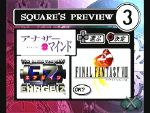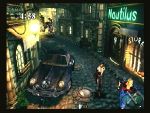|
Final Fantasy VIII - Demo
Impressions - Part 2 |
RPGamer gets down and delves
deeply into the demo's details
By Brian Glick, RPGamer Writer

|
|
Choose your Dose-'O-Squaresoft
|
Final Fantasy VII's first demo was something to get
actively excited about. With the first real glimpse at the PlayStation's
first Final Fantasy, gamers and the media were sampled with a treat of
what the game would essentially feel like. And when the final release
hit the shelves in Japan, players discovered how the demo was just that;
a demonstration, with the actual title being far above expectations.
If history repeats itself, Final Fantasy VIII is
something to get very excited about. The demo is a tour de force
of amazing visuals, immersive gameplay, and from what we've read so far,
the storyline shows a remarkable amount of promise, despite seeming
cliched at times.
The demo opens with a large, pale moon filling the
screen, accompanied by a low, hesitating melody. What appears to be a
formation of jet fighters fill the screen, and the "Final Fantasy VIII -
Trial Version" logo flashes by. As the screen fades away with undulating
ripples, a fleet of small battle ships comes into view. This may seem to
indicate that the "jets" were actually the boats viewed from overhead,
and the moon was a reflection hovering in the water.
On one of the boats is our hero, Squall. He looks
down at a map containing the battle plans for the shoreline he is quickly
approaching. He narrows his eyes, and either seems to remember some sort
of battle in his past, or manages to see the war in progress at his
destination. The boat smashes through a wall surrounding the beach at
their destination, the hamlet of Dollet, and lands on shore. The door
opens up, and Squall and his party dash out.
The first time I observed this scene, with the
characters dashing from the boat, I thought that they were rather poorly
rendered. Only when they started talking did I realize that they were
polygons, and that the scene has transitioned from a CG movie to regular
gameplay so seamlessly I hadn't even noticed it. Throughout the demo,
the characters move fluidly, with exaggerated expressions and nuances of
movement that reveal just how much time the artistic designers and
programmers of the game must have spent observing everyday body language
(Answer: a lot). This can be seen particularly during CG scenes with the
characters fully rendered: attention to detail is so minute that you find
yourself watching the way Squall's necklace swings in the air as he jumps
for safety, and even the dog in Dollet's plaza moves so realistically
that dog lovers will doubtlessly take a liking for the nameless pooch.

|
|
The draw command steals magic from foes
| |
Getting down to gameplay, Final Fantasy VIII excels.
At the meat and bones of any RPG is the battle system. Just as every
previous Final Fantasy game in the series has done, FF VIII's system has
been tweaked and changed. The most dynamic and controversial change is
the "draw" system. Characters no longer learn a spell they can cast ad
nausem until their magic points dry out -- in fact, FF VIII doesn't have
any magic points at all. Magic must be stolen, or "drawn" from your
enemies. In the menu, you first select the "draw" command. Choose your
enemy, and you're presented with a list of the drawable magic spells.
After choosing your spell, you must choose between "Use" (or "Release"),
and "Stock." By choosing Use, you immediately cast the spell, using your
foe's magical strength. By selecting Stock, however, your turn is used
to pull a random number of spells from your enemy, which you can then use
later in your typical "Magic" menu option. By choosing to stock magic
instead of using it right away, you lose a turn, but you stand the chance
of gaining more than one spell which you can then cast with your own
potentially greater magical strength than the enemy's. While the demo
seemed to have no limitation to the amount of magic you could draw, the
final version will most likely have a set amount of magical spells per
enemy.
Keeping the tradition of previous games, summoned
monsters are back in the FF VIII demo. Just like in FF VII's demo, you
are able to call the twisting, devastating Leviathan, who brings waves
and waves of water crashing down upon your foes from a spontaneously
created mountain. Since there is no magic point system in the game, by
selecting a Guardian Force monster (the term by which summoned monsters
are known), your character's speed bar in battle fills with blue and
begins decreasing in the opposite direction of the typical speed bar.
When the blue bar disappears, your summoner calls the beast. Presumably,
stronger summoned monsters will take a longer time to call.
Additionally, summoned monsters are expected to gain experience with each
summon in the final version, although evidence of that was not found in
the demo.
Final Fantasy VIII seems to keep the "limit break"
system of Final Fantasy VII. After a non-visible amount of damage is
dealt to a character, an arrow appears beside the typical "fight" command
on their next turn, allowing you to select a special attack. If the
attack is not used, however, or even if you switch to another character
temporarily, the limit break is lost. Additionally, with Squall's unique
gunblade, you might think that Squall is a fairly weak character until
you discover that by hitting the R1 button just as he begins his downward
stroke of the blade, Squall pulls the trigger, releasing extra energy
into the blade that deals a great deal more damage.
Further detail has also been paid to the characters
in battle. Character models used are identical to the models outside of
battle, meaning high detail. When casting spells, the camera shifts
angles quickly, zooming in on the characters at twisting angles and
quickly changing shots. While the camera may stay stationary at other
times, it seems to move around randomly at times, quickly panning in one
moment and offering a totally different perspective at another. When the
battle has been won, a variety of different camera paths are followed
each time as the focus shifts to the characters. If Squall finished off
the enemy, the view might even focus solely on him, ignoring the other
two characters' celebrating.

|
|
Dash to escape in the climatic finale
|
Getting to the characters themselves, the more
realistic character designs are a refreshing change of pace. They are
tall and thin (perhaps, too thin), but manage to keep the same type of
extreme emotional mannerisms found in FF VII that helped led to its
friendly appeal and environment. Zell, for example, is an energetic
young man that parallels Sabin from FF VI not only in looks, but also in
brashness and wit. Squall exudes a coolness which can't fail to intrigue
the player.
The storyline flows well in the demo. Squall and his
companions seem to be on a mission to the town in order to gain entrance
to the elite group of the Garden academy known as "SeeD." Throughout the
demo, though, a tension-filled rivalry exists between Squall, and the man
who seems to be the leader of the mission, Seifer. Seifer's arrogance
appears to be fabricated and directed towards Squall, who can barely
maintain his tolerance of Seifer. It will be interesting to see what
kind of role Seifer plays in the game, in addition to the already
promising plot that awaits the player.
Nobuo Uematsu's music in the demo is varied, although
sparse. What's there, however, contains and builds upon the range of
emotions, from the mysterious melody at the beginning of the demo to the
fast paced, climatic finale at the end. Together with the music, the
finale of the demo leaves a very favorable impression upon the player,
craftily designed to create even greater anticipation (and higher sales)
of the final game.
Finally, Final Fantasy 8 takes advantage of the Dual
Shock controller from Sony. The controller is a must-have for anyone
that fully wants to experience the game. While the analog controller
only offers you two different movement speeds (walking, and running), you
are able to turn and move far more fluidly. Far more importantly,
though, is the vibration in the controller. The vibration is handled
flawlessly, with extreme detail to magnitude and frequency. Not only
does it shake when major spells are cast, and when explosions and
rumblings occur during CG scenes, but it also provides vibration to
complement the visual feedback when you successfully hit the R1 button at
the right time in battle. One annoyance about the controller, however,
is that the analog pad is not suited for battles. It should become
second nature to simply switch between the D-pad when a battle ensues,
and to move back to the analog pad afterwards, though.
For now, all we can do is sit back and wait until
sometime in 1999 for Final Fantasy VIII to reach North America. Will it
be worth the wait? Yes. Will it be easy? Most certainly not.
Back to Part 1
|









